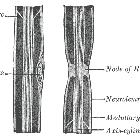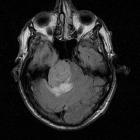jugular schwannoma
Jugular foramen schwannomas are a rare type of intracranial schwannoma that presents as a jugular fossa mass involving the jugular foramen.
Epidemiology
In those without neurofibromatosis type 2 (NF2), they tend to present between the 3 to 6 decades of life. There is a recognized female predilection . The tumors can have a wide variety of clinical presentations.
Pathology
They can arise from cranial nerves IX, X or XI, with IX being the most common .
Associations
- neurofibromatosis type 2 (NF2): particularly if bilateral
Radiographic features
CT
- usually well-demarcated
- tend to be iso to hypoattenuating to brain parenchyma
- may show expansion and remodeling of the affected jugular foramen
- may have a characteristic dumbbell configuration
MRI
Signal characteristics are those of a schwannoma:
- T1: typically low signal
- T2: typically high signal
- cystic degeneration may be seen in larger tumors
- T1 C+ (Gd)
- smaller lesions demonstrate intense homogeneous enhancement
- larger lesions tend to have heterogeneous enhancement
Treatment and prognosis
As with most schwannomas, they tend to be slow-growing tumors. Surgical resection is often the treatment of choice.
Differential diagnosis
For a full list of differentials see the article on jugular fossa masses. Considerations in this location include:
- paraganglioma: glomus jugulare tumor
- “salt and pepper” appearance on MRI with intense contrast enhancement and multiple small flow voids
- vascular schwannomas may have peripheral flow voids but should not have internal flow voids
- if large, irregular erosion of the margin of the jugular foramen, with decalcification or destruction of the surrounding bone
- possible invasion of jugular bulb/vein with intraluminal growth (compared to compression by schwannomas)
- “salt and pepper” appearance on MRI with intense contrast enhancement and multiple small flow voids
- meningioma around the jugular foramen
- metastatic malignant tumors or lymphoma
- may be indistinguishable from schwannoma when involving jugular foramen
- most likely destruction of surrounding bone, with less sharply marked borders
Siehe auch:
- Glomus jugulare Tumor
- Schwannom
- Foramen jugulare
- neurilemmoma
- jugular foramen meningioma
- Schwannome der Hirnnerven
- intrakraniale Schwannome
- Neurilemm
- jugular foramen mass
und weiter:

 Assoziationen und Differentialdiagnosen zu jugular schwannoma:
Assoziationen und Differentialdiagnosen zu jugular schwannoma:




